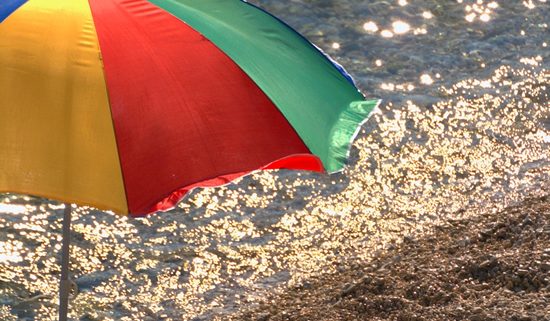Geographical position and climate
Within the relief zone of the entire Podstrana area, three parallel morphological units significantly differ from each other: 1. lime-stone mountain-ridge, 2. flysch slope and 3. coastal alluvium.
The Perun lime-stone mountain ridge is the highest and most outstanding position with an average height above sea level of some 450 m. The Perun ridge steeply descends around 100-170 m in a south-westerly direction and in some places ends with diluvial rock scree (“turner’s lathe”) which cover the bond with the nearby flysch slope.
The Eocene flysch slope, as a second morphological unit, is the most widespread in Podstrana. It is slightly inclined (on average by 15º) from the scree at the bottom of lime-stone ridge to alluvium by the sea shore and the Žrnovica River’s lower flow.
Coastal relief continues in the Brač Channel’s underwater. The bottom, which reaches some 30 m follows the flysch slope’s inclination (some 15º) and then very slightly is inclined towards the centre of the channel where only a few positions surpass a depth of 50 m.
The average temperature of the surface layer of the sea in front of Podstrana is 17.5 ºC. During the winter months the sea temperature varies from 12.5 to 13.0 ºC, and during the summer between 23.0 and 26.0 ºC. The surface sea layer salinity near the Podstrana shore varies from 36.0/00 during the winter up to 38 0/00 during the summer. The surface sea gulf by the shore moves in a southeast to north-westerly direction.
TERRAIN AND FLORA
Under the influence of the geological structure, relief, climate and vegetation in the Podstrana area, and with regard to the three geo morphological units, specific terrain types have developed. The lime-stone is subject to chemical erosion when insoluble component mineral parts, such as red soil (“terra rossa”) remain in the fissures and cavities. As the mineral component part in the lime-stone area is relatively low, only 1-3%, notwithstanding more than ten thousand years’ of chemical erosion, a relatively small amount of red soil has accumulated in these karst fissures. However, it has provided a foundation for the spread of a covering of vegetation from which brown and black earth has developed on the surface above the red soil.
Barren land with low grass cover prevails along the steep slopes of the mountain ridges landscape with aromatic bushes and unconnected trees of Aleppo Pine (Pinus halepensis) whilst the ledge above is rocky ground with low grass and conifer bushes. The remains of oak trees on the area of old Podstrana enables us to conclude that before this area was inhabited, the flysch slope was covered with Downy Oak forests (Pubescent Oak, Querces pubescens). Besides the pine tree, Spanish Broom (Spartium Junceum) is also very widespread here.


